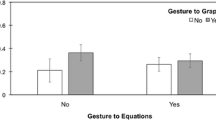Abstract
This study focused on how an instructor’s pointing gestures and depictive gestures differentially affected learners’ retention, transfer, and visual attention allocation. Eighty-five Chinese undergraduates were randomly assigned to view one of three video lectures in a laboratory. The videos varied in terms of the instructor’s use of gesture: pointing gestures, depictive gestures, or no gestures. As hypothesized, the results showed better learning performance after the videos that included either pointing gestures or depictive gestures relative to the no gestures video; interestingly, the effect of gestures in video lectures was greater for participants with low and medium prior knowledge. In addition, the type of gesture differentially affected learners’ visual attention allocation: pointing gestures directed attention to the relevant learning content of the PowerPoint slides, and depictive gestures drew learners’ attention to the instructor. The findings have practical implications: instructors are encouraged to use pointing gestures and depictive gestures in video lectures.

Similar content being viewed by others
References
Alibali, M. W., & Nathan, M. J. (2012). Embodiment in mathematics teaching and learning: A view from students’ and teachers’ gestures. Journal of the Learning Sciences, 21(2), 247–286.
Alibali, M. W., Nathan, M. J., Church, R. B., Wolfgram, M. S., Kim, S., & Knuth, E. J. (2013). Teachers’ gestures and speech in mathematics lessons: Forging common ground by resolving trouble spots. ZDM Mathematics Education, 45(3), 425–440.
Alibali, M. W., Nathan, M. J., Wolfgram, M. S., Church, R. B., Jacobs, S. A., Martinez, C. J., et al. (2014). How teachers link ideas in mathematics instruction using speech and gesture: A corpus analysis. Cognition & Instruction, 32(1), 65–100.
Arslan-Ari, I. (2018). Learning from instructional animations: How does prior knowledge mediate the effect of visual cues? Journal of Computer Assisted learning, 34, 140–149.
Congdon, E. L., Novack, M. A., Brooks, N., Hemani-Lopez, N., O’Keefe, L., & Goldin-Meadow, S. (2017). Better together: Simultaneous presentation of speech and gesture in math instruction supports generalization and retention. Learning & Instruction, 50(6), 65–74.
Cook, S. W., Duffy, R. G., & Fenn, K. M. (2013). Consolidation and transfer of learning after observing hand gesture. Child Development, 84(6), 1863–1871.
Goldin-Meadow, S. (2014). How gesture works to change our minds. Trends in Neuroscience and Education, 3(1), 4–6.
Goldin-Meadow, S., Cook, S. W., & Mitchell, Z. A. (2009). Gesturing gives children new ideas about math. Psychological Science, 20(3), 267–272.
Hayes, A. (2018). Introduction to mediation, moderation, and conditional process analysis: A regression-based approach (2nd ed.). New York: The Guilford Press.
Holmqvist, K., Nyström, N., Andersson, R., Dewhurst, R., Jarodzka, H., & Van de Weijer, J. (2011). Eye tracking: A comprehensive guide to methods and measures. Oxford: Oxford University Press.
Kalyuga, S. (2014). Prior knowledge principle in multimedia learning. In R. E. Mayer (Ed.), The Cambridge handbook of multimedia learning (pp. 576–597). New York: Cambridge University Press.
Kang, S., Hallman, G. L., Son, L. K., & Black, J. B. (2013). The different benefits from different gestures in understanding a concept. Journal of Science Education and Technology, 22(6), 825–837.
Koumoutsakis, T., Church, R. B., Alibali, M. W., Singer, M., & Ayman-Nolley, S. (2016). Gesture in instruction: Evidence from live and video lessons. Journal of Nonverbal Behavior, 40(4), 1–15.
Mayer, R. E. (2005). The Cambridge handbook of multimedia learning. New York: Cambridge University Press.
McNeill, D. (1992). Hand and mind: What gestures reveal about thought. Chicago: University of Chicago Press.
Moreno, R. (2007). Optimising learning from animations by minimizing cognitive load: cognitive and affective consequences of cueing and segmentation methods. Applied Cognitive Psychology, 21(6), 765–781.
Pi, Z., Hong, J., & Yang, J. (2017). Effects of the instructor’s pointing gestures on learning performance in video lectures. British Journal of Educational Technology, 48(4), 1020–1029.
Pi, Z., Zhang, Y., Zhu, F., Xu, K., Yang, J., & Hu, W. (2019). Instructors’ pointing gestures improve learning regardless of their use of directed gaze in video lectures. Computers & Education, 128, 345–352.
Ping, R., Goldin-Meadow, S., & Beilock, S. L. (2014). Understanding gesture: Is the listener’s motor system involved? Journal of Experimental Psychology: General, 143(1), 195–204.
Rueckert, L., Church, R. B., Avila, A., & Trejo, T. (2017). Gesture enhances learning of a complex statistical concept. Cognitive Research Principles & Implications, 2(1), 2–7.
Wilson, M. (2002). Six views of embodied cognition. Psychonomic Bulletin & Review, 9(4), 625–636.
Yang, J. (2014). The effect of the instructor on learning process and effectiveness in online video courses. Unpublished doctoral dissertation, Central China Normal University, Wuhan.
Acknowledgements
This work was supported by the China Postdoctoral Science Foundation (2018M631118); the Fundamental Research Funds for the Central Universities (GK201803076; 19XJC880006); the Research Projects of Humanities and Social Sciences Foundation of Ministry of Education of China (17YJAZH104); and the National Natural Science Foundation of China (61877024).
Author information
Authors and Affiliations
Corresponding authors
Additional information
Publisher's Note
Springer Nature remains neutral with regard to jurisdictional claims in published maps and institutional affiliations.
Rights and permissions
About this article
Cite this article
Pi, Z., Zhang, Y., Yang, J. et al. All Roads Lead to Rome: Instructors’ Pointing and Depictive Gestures in Video Lectures Promote Learning Through Different Patterns of Attention Allocation. J Nonverbal Behav 43, 549–559 (2019). https://doi.org/10.1007/s10919-019-00310-5
Published:
Issue Date:
DOI: https://doi.org/10.1007/s10919-019-00310-5




